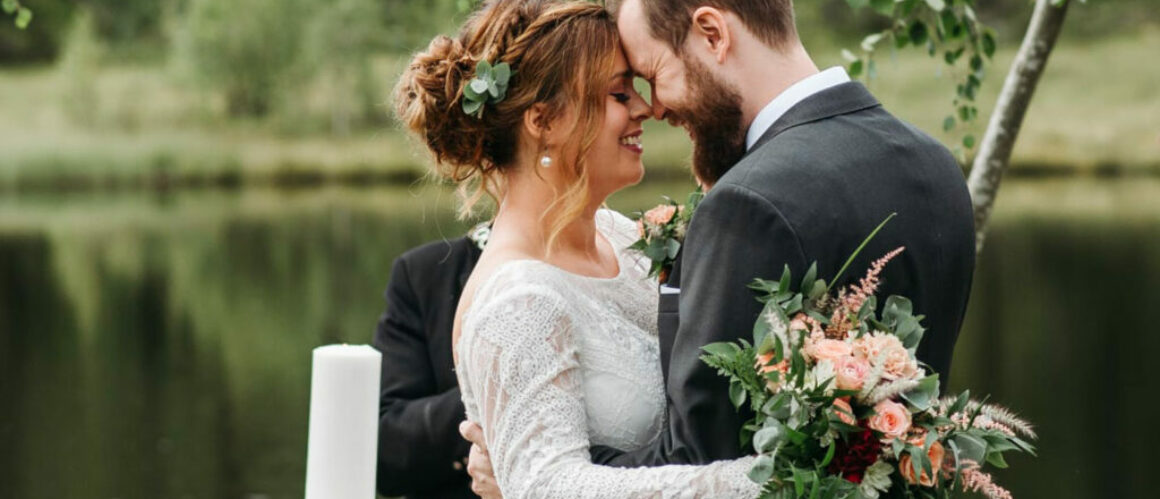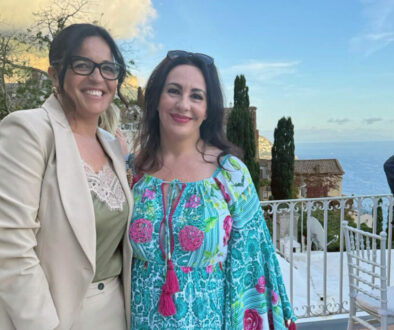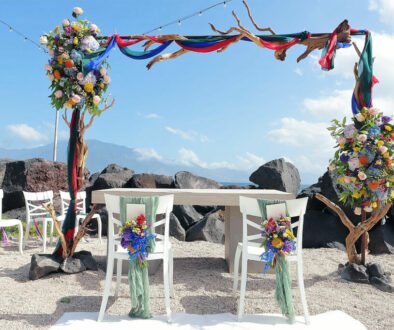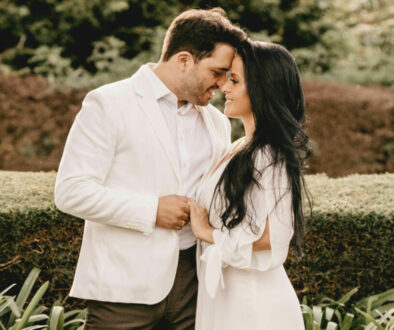Here we explain them in detail and help you choose the one that’s right for you and tell you when and what you need to organize it.First let’s talk about what the symbolic ceremony is.
When approaching symbolic marriage for the first time, one of the first things that comes to mind is: how can we make the moment of union meaningful?
After all, it is not a shared marriage, so there will be no signatures in the registers to mark the moment of the union, and it is not a church wedding, so there will not be the classic phrase “do you want…” (unless you wish).
So how do we create unity?
Symbolic rituals are the most personal way to tell your love story.
This article will help you to know everything, absolutely everything, about the symbolic rites you can choose for your wedding and how to personalize them.
THE RITES OF UNION
Union rites can be completely invented, or they can take inspiration from more ancient rites, used by populations, often pre-Christian.
I always recommend, therefore, when a ritual remains in our hearts, to inform ourselves about its origins, so as to honor it and not distort it. Each ritual has a particular closeness to one of the natural elements. It has always been like this since man is part of nature and, until not long ago, knew he belonged to it.
Why choose one ritual over another? The choice of ritual depends on the couple’s history and their personality. One thing you absolutely need to know is that each element is linked to a specific meaning:
AIR ELEMENT: it is a masculine element. It represents vital energy and is associated with communication with oneself and with others, sociability, change, flexibility, lightness in things. It concerns all the faculties of the intellect and mind: speech, creativity, thought, art, music, imagination, singing, laughter, mental enjoyment, poetry and inspiration.
FIRE ELEMENT: it is a masculine element. It represents action, the beginning of things, exuberant vitality. Associated with it are the qualities of courage, strength, passion and determination.
WATER ELEMENT: it is a feminine element. It represents the vital element from which everything is born, the womb, the source of nourishment and has always been the link with spirituality. Flexibility, flowing emotions and receptivity are associated with water. It is the element of internalization, which gives purification, movement, understanding.
EARTH ELEMENT: it is a feminine element. It represents fertility, even creative, nourishment and for this reason it is linked to earthly things, to materiality. The qualities of strength, perseverance and patience are associated with it and it gives material abundance. For this reason in the various rites you will always find a reference to the element to which they are most linked.
What symbolic wedding rites can you choose to get married?
There are many symbolic rites, in reality there is no precise number and in any case the symbolic ceremony can always be reinvented and rediscovered…according to the needs of the spouses: More than anything else a symbolic rite is like a blank canvas where, little by little, the couple’s personalized celebration will take shape.
Some of them belong to other cultures, others have a very ancient tradition behind them and still others represent the true essence of union for life. Symbolic rites are the icing on the cake to make a civil wedding or your symbolic wedding more personal and engaging.
What if you get married with a religious wedding?
There are specific ones and some, such as the sand ritual, which you can also apply to this type of ceremony
In the latter case, always ask for more detailed information from the priest who will celebrate the wedding to obtain permission and/or to verify that there are no limitations or prohibitions.
What are the most used symbolic rites? Among the best known we have five:
- Sand ritual
- Ritual of light
- Tied hands ceremony
- the Ring Warming ritual
- Symbolic rose ritual
Sand Rite: Earth Element/What is it?
The symbolic sand ritual is certainly the best known in the world and symbolizes the eternal union between two people, while still remaining two distinct and separate beings. In a certain sense, it refers to the classic “until death do us part” of religious marriage: the two spouses can no longer be divided just as it is impossible to divide every single grain of sand.
The origins of the symbolic sand ritual, however, are different and can be traced back to the Native American tribes who celebrated weddings on the beach.
What is it about
During the sand ritual the spouses pour a little sand of two different colors into a single vase. This marriage rite can also be celebrated with the children pouring sand of other colors together with their parents.
What do you need
If you are among those who have always wanted it for your wedding, know that first you need to get 3 vases, two small and identical to each other and one larger one. You can find colored sand in specialized DIY stores, or online you can also purchase ready-to-use kits for the sand ritual. Alternatively you can create a DIY sand ritual by personalizing the jars with your names and the wedding date. The sand ritual, like most symbolic wedding rites, can be included in the civil ceremony and during the symbolic wedding.
What if you get married in a religious ceremony? No fear! The sand ritual can also be celebrated in a church
Rite of light: Element of fire and is considered among the most spiritual of symbolic wedding rites
The light rite or candle rite is the most spiritual of the symbolic wedding rites. It originates in religious ceremonies during which candles are often used. Without forgetting the Bible, in which there are many references to light. The meaning of the rite of light is therefore very profound because it represents the union of two souls, forever.
What is it about
During the ceremony the spouses light, with a candle each, a candle placed between them which is thus fed by a flame that arises from theirs. As in the case of the sand ritual, the light ritual can also be celebrated with the children who, as a result of the spouses’ love, can hold the candles together with them.
What do you need
If you are thinking of choosing it, you can personalize the candles with your initials or purchase a kit for the light ritual.
Handfasting, this is what the ritual of the 4 elements is
The Handfasting rite, also known as the rite of the 4 elements or the rite of tied hands, has Celtic origins.
Mainly widespread in Ireland and Scotland, it is also very popular in Italy for its profound meaning of eternal love linked to the boundless power of nature.
What is it about
During the ritual the hands of the spouses are tied to each other by the celebrant with cotton, satin or silk ribbons, 3 times.
What do you need
There are 4 ribbons in the original ritual and represent the 4 natural elements: water, air, earth and fire. Irish tradition also allows a version of the ritual with 13 ribbons, each with a different colour, meaning and wish for the spouses: for example love, health, prosperity and fertility. The colors chosen for the ribbons are usually red for the groom and white for the bride, which symbolize the man and the woman respectively. Alternatively, you can choose 4 different colors or just one, for example the one chosen as the wedding theme
Rite of the warmth of the rings: earth element, let’s see how the Ring Warming takes place
The love infusion ritual or Ring Warming (i.e. heating the rings). Also known in Italy as the ritual of the heat of the rings, it allows guests to take part in the ceremony firsthand.
What is it about
To put it into practice you will have to give the wedding rings to one of the guests who will pass them to another and then to another and so on. Each guest can recite a prayer, kiss them or simply hold them to their chest as a sign of good luck. The wedding rings are thus worn by the spouses after having been literally warmed by the affection of friends and relatives.
What do you need
In addition to collaboration – indispensable! – of your friends and relatives, you must equip yourself with a colored ribbon to tie the wedding rings together or a small fabric bag (organza, silk and jute are the most popular) in which to store the rings. A valid alternative could also be to place the wedding rings inside a small personalized box
Symbolic ritual of the rose, Earth element for the most romantic brides. It is, par excellence, the flower symbol of true, passionate love that shocks you.
The rose is the protagonist of the most romantic symbolic ritual of all: the rose ceremony.
What is it about
The ritual is based on the exchange of a rose between the spouses: it is the moment in which each gives their life to the other. Both roses are then placed in a vase placed on a table for the duration of the ritual. After the wedding, roses can be planted or dried, preserving them forever.
What do you need
In summary, to celebrate this symbolic ritual you need to have: 2 red roses or in the color you prefer and a glass, ceramic or wooden vase to place them at the end of the celebration.
Ancient marriage rites, the 4 you need to know
Suggestive, profound and certainly the most traditional.
There are four very ancient symbolic rites that you can choose for your wedding and each is more beautiful than the other. All borrowed from other cultures, they are:
- Chuppah ritual;
- Rite of the floral lasso;
- Oathstone ceremony or Celtic stone;
- Sugar ritual.
Chuppah ritual
The Chuppah ritual, as you can easily imagine, was born in Jewish culture and has very ancient origins: think that it is also mentioned in the Bible, in the book of Genesis! The Chuppah is the canopy under which Jewish weddings are celebrated and symbolizes the house built by the spouses after the wedding. In the actual symbolic rite, the Chuppah is reproduced by a blanket, usually sewn and embroidered by hand, with which the parents wrap the shoulders of the bride and groom.
The ritual ends when the bride circles the groom 7 times. A very important gesture that represents the birth of the new family.
Symbolic rite of the floral lasso
The symbolic ritual of the floral lasso resembles, in some ways, that of Handfasting, but was born in Mexican and Spanish culture. The main difference is that the union is celebrated with two necklaces of flowers, one intertwined with the other, tied around the neck of the spouses in the shape of an “eight” like the symbol of Infinity (∞). The flower necklaces are then worn by the spouses throughout the ceremony, until the end of the reception. Finally, both ribbons are delivered to the bride who will dry them as a reminder of their promise of love.
Oath Stone Rite
And if we talk about ancient marriage rites, the oath stone certainly cannot be missing! This symbolic ritual also originates in Celtic culture and recalls the strong spiritual bond with nature. The love celebrated between the spouses is imprinted on a stone held between their hands during the wedding vows. If this is the rite with which you want to celebrate your union for life, know that you can personalize it by engraving your name on the stone next to that of your partner and the wedding date.
The additional idea
Follow tradition carefully and also decorate the stone with a symbol that represents your couple.
After the wedding you can choose whether to: keep the oath stone at home, bury it in the garden or return it to nature by throwing it into the sea or a lake. All gestures that symbolize eternal love.
Symbolic sugar ritual
The symbolic sugar ritual has Persian origins and is literally the “sweetest” of all. In this photo one of the ancient symbolic wedding rites: the sugar ritual. Two newlyweds are filmed smiling under a lace veil held by friends and relatives while one of the mothers rubs two sugar cones on them. Similar to the religious rite of velatio or veiling (which we will describe later), to carry it out you and your groom will need the help of your friends and their respective mothers. Friends or wedding witnesses take care of keeping a veil tightly stretched over the heads of the bride and groom as a symbol of the new home. The mothers conclude the ritual by rubbing two cones and letting down many grains of sugar as a wish for a happy life together.
Special wedding rites: find the one that’s right for you
Special like you, exciting like the birth of your couple.
Symbolic rites for particular weddings are what you need for a ceremony that represents you completely. In the next paragraphs we will tell you about the 4 most beautiful, most curious and which you will certainly fall in love with:
- Wine ritual;
- Tree Planting Ceremony;
- Memory box ritual;
- Colour ritual.
Symbolic wine ritual
The symbolic wine ritual, which you can also hear called Wine Box Ceremony, is very widespread in Anglo-Saxon countries, but has also won over many Italian brides. The wine ritual develops in two moments. A few days before the wedding, the bride and groom keep a bottle of red or white wine in a box. Then, on the wedding day, the box is opened and the newlyweds can choose whether to uncork the bottle and toast together with the guests. During the ceremony, some couples choose to place two love letters next to the bottle to read or keep as a private memento. In the latter case, the ritual is called Wine Box and Love Letters Ceremony, that is, the ceremony of the box of wine and love letters.
Tree Planting Ceremony
With roots firmly rooted in everyday life.
If you see yourself and your partner in this description, well, the symbolic ritual that represents you is that of Tree Planting.
Tree Planting.
During the Tree Planting Ceremony, the spouses plant a small tree or shrub inside a pot, covering the roots with earth and watering them. It is a ritual with strong symbolism that continues even after the wedding: the plant and the earth represent the love that you and your husband will nurture day by day.
Symbolic ritual of the memory box
The memory box ritual is one that you can customize from start to finish. The ceremony consists of placing some objects in a box that represents a suitcase to be closed before leaving for your favorite adventure.
First, choose or build (if you are good at handmade work) a box made of wood, cardboard or any material you like.
On the lid write your name and that of the groom and the wedding date.
Finally, collect all the objects that represent the values and memories you have in common and the promises you will exchange.
Color ritual
All the shades of your love that blend together forever. This is the heart of the symbolic ritual of colors or Unity Painting Ceremony. During the ceremony the spouses paint a canvas or, if you like the idea, a terracotta object with a brush or jars of paint. The ritual ends when the two colors, completely mixed, have become one. If you choose this ritual for your wedding, you will be able to keep the canvas painted in this way as a memory of that moment.
Symbolic rites for religious weddings: what are they?
If so far we have described the symbolic rites most chosen by brides for civil weddings and symbolic ceremonies, but this is not your case, know that there are also those for religious weddings.
There are 2 symbolic rites for religious weddings, both taken from Orthodox weddings:
- velatio or veiling;
- coronation.
The Church authorized the inclusion of these rites in Catholic weddings in 2004.
For this reason, if you wish to include one in the celebration of your wedding, make this known to the priest who will marry you: he will take care of asking for authorization from the Bishop of your Diocese. On the contrary, if yours is a mixed Orthodox-Catholic marriage, you do not need any permission.
Velation or velatio nuptialis
Velation, which you have also heard called by its Latin name of velatio nuptialis, is the symbolic religious rite best known and most chosen by brides. The veil involves 4 people, usually the witnesses or parents of the bride and groom, holding a cloth or the bride’s veil (or, to make the moment even more intense, the bridal veil of one of the mothers) over the heads of the bride and groom. The veil represents the descent of the Holy Spirit who protects the couple and their future married life. In fact, during the ritual, the priest recites a prayer of blessing.
Coronation
Even the coronation, also known as the rite of the crowns, is a symbolic rite with a strong emotional charge. It works like this: the priest who celebrates the wedding places 2 crowns on the heads of the spouses and, in the meantime, pronounces a prayer of blessing. The symbolic coronation rite symbolizes the union with Nature and with God. And in fact, according to tradition, the bride and groom make the wedding crowns by hand, intertwining both plant and mineral elements. But the coronation also has another meaning: the spouses give themselves to each other in the Grace of the Lord.
Other lesser-known rites:
Herbal Rite
This ritual is close to the earth element.
HISTORY: Herbs had an important value for the ancients. Healing depended on knowing how to recognize them and, therefore, some had a special place in the culture.
HOW IT IS DONE: Before the wedding, the spouses choose some herbs to which they are attached. Of course, if you want to create a herbal tea with the herbs that you can then drink, it is necessary to choose aromatic herbs suitable for the purpose, which are therefore edible. If, however, you want to use the herbs to create incense, you will need to choose those suitable for fumigation. If you have no knowledge about herbs, go to a herbalist’s shop for help in choosing.
During the ritual, everyone will have their own container with their chosen herbs. One in front of the other, the spouses will pour their herbs into a larger container. What will result will be the mixture of the new family, which will be preserved and consumed by the spouses either as herbal tea or as incense.
You can consult a herbalist to choose herbs.
Fairy Tree Rite
ELEMENT: This ritual is close to the element of air.
HISTORY: In Ireland many trees are considered sacred, also called fairy trees. This tradition has its roots in Celtic culture, for which some trees more than others, especially those that grew on the border between land and water, had a special importance, as threshold trees between our world and the sidhe, the Celtic Otherworld where the gods, the ancestors and the small people dwell. It was once believed that hanging a small ribbon from the low branches of a sacred tree, asking for healing or expressing a wish, would bring the request to the Otherworld and be fulfilled. Even today in Ireland you can find various trees decorated with many ribbons.
HOW IT IS CARRIED OUT: The ritual itself is very simple, but gives the opportunity to involve the guests. It can be carried out as a real union rite for the spouses, or as an additional rite, at the beginning or end of the wedding, to also make the guests express a wish. First prepare as many ribbons as there are people who will have to make a wish and, if desired, also some pieces of paper and pens or pencils. At the designated time the spouses can decide either to hang only the bow together, or to first write a note, which possibly will remain attached to the tree forever, or which will be burned, and then hang it on the tree. The variant with guests takes place in the same way, but in this case the notes will be detached from the tree, unless the ritual takes place in a private area with permission to leave them attached. If they are detached, it is nice that the notes, with the wishes of the guests, are never read, but burned, perhaps all together in the evening, or buried you. In this case I recommend using plantable paper.
Rite of the prayer of protection
ELEMENT: This ritual is close to the earth element.
HISTORY: This is a ritual of English tradition, but in reality it has its roots in a much older, Celtic, but probably even earlier time. Druids used to draw circles around themselves for protection at certain sacred times. Generally the circle was traced with a branch of a certain significant tree and in the meantime a song was sung, called Caim, a prayer of protection.
HOW IT IS CARRIED OUT: The ritual takes place with all the guests arranged in a circle around the spouses. The celebrant, or a person dear to the couple, will take a chosen branch and drag it while walking in a circle around the guests. If desired, everyone can repeat a phrase together or sing a short song, or it can be done with everyone’s eyes closed to the sound of the harp.
The circle, which symbolizes the community, creates a protection zone around the couple. Usually when we use this ritual we combine it either with the fairy tree ritual or with handfasting
Ritual of Idromiele
ELEMENT: This ritual is close to the element of water.
HISTORY: Mead is the oldest alcoholic drink that appears in the history of the Indo-Europeans. It is the drink of the gods and ritual moments. The Druids considered it sacred because it was produced by the fermentation of honey, which was also sacred because it was produced by bees. Furthermore, the Celts had a high regard for bees because they fed on the nectar of certain flowers, which were also of special importance.
This drink was consumed abundantly during the month following the wedding, as it was thought to give fertility. From this practice arose the custom of defining the period following the wedding as the “honeymoon”, since consumption lasted for a month, or one lunation.
HOW IT DEVELOPMENTS: The bride and groom, one in front of the other, fill the glass with the mead. The groom hands it to the bride, who drinks, then passes it to the groom who does the same. The passage occurs three times and a sip is taken three times. The number three is, in fact, the sacred number of completeness.
If you don’t like mead, you could use apple cider or spring water for the same purpose. Once upon a time, a couple, not liking alcohol, decided to create a herbal water. You could therefore leave some herbs dear to you to infuse in water overnight and then use the filtered water instead of mead.
Also in this case, to choose the best herbs you can consult a herbalist




